Menus
- Two concepts, one champion
- The eternal dispute of the systems: V2 against inline four-cylinder
- The four-cylinder Kawasaki Z 800 is rougher
- Ducati Monster 821 weighs 22 kilos less
- ABS on board on both bikes
- Technical data Ducati Monster 821
- Technical data Kawasaki Z 800
- Readings
- rating
- Bottom line and conclusion
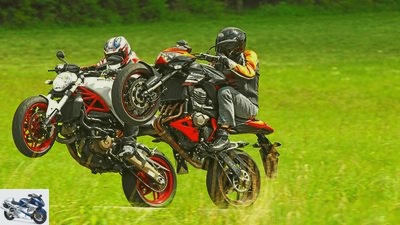
Bilski
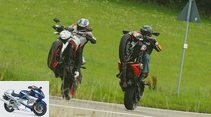
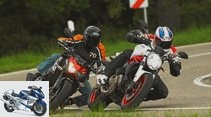
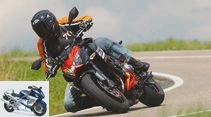
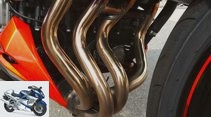
34 photos
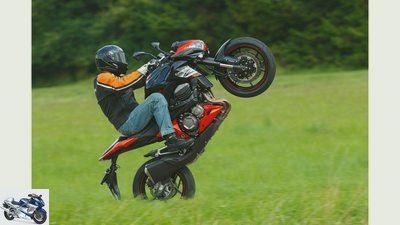
Bilski
1/34
Kawasaki Z 800.
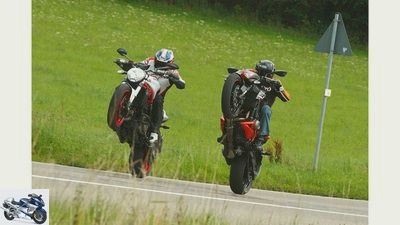
Bilski
2/34
Ducati Monster 821 and Kawasaki Z 800 in comparison test.
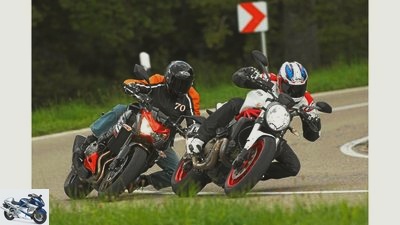
Bilski
3/34
Ducati Monster 821 and Kawasaki Z 800 in comparison test.
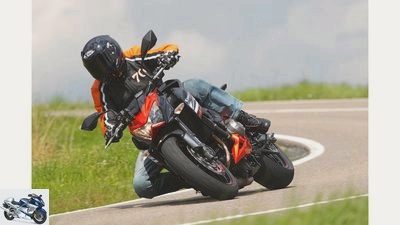
Bilski
4/34
Kawasaki Z 800.
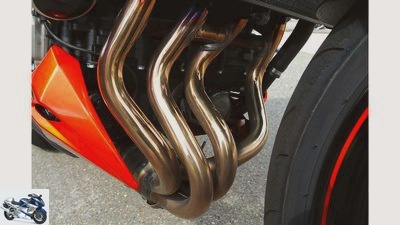
Bilski
5/34
Kawasaki Z 800.
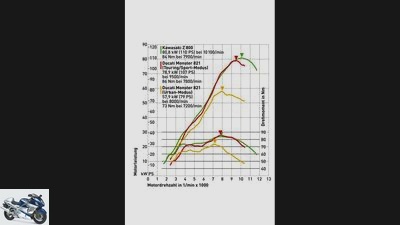
Bilski
6/34
Readings.
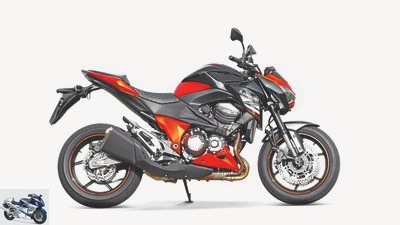
Bilski
7/34
On the plus side of the Kawasaki Z 800 is the extremely powerful engine that gives the Zett great dynamism. On the drive side, it gives away a few points because of a lack of traction control, rough engine running and delayed throttle response.
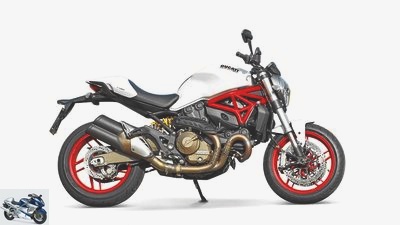
Bilski
8/34
The Ducati Monster 821 celebrates a successful debut with a clear test victory. The best thing about it is the handy and precise chassis that can handle even the sporty pace.

Bilski
9/34
Curved elbows bring the necessary pipe length. The four-cylinder is a rough fellow, but delivers plenty of lard.
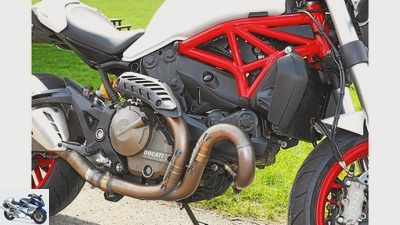
Bilski
10/34
Space frame with motor as a load-bearing element. When driving, the right leg sometimes hits the manifold cover of the lying cylinder.
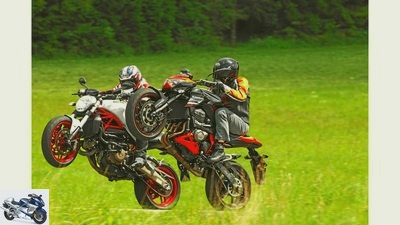
Bilski
11/34
With the Ducati Monster 821 and the Kawasaki Z 800, two cultures meet.
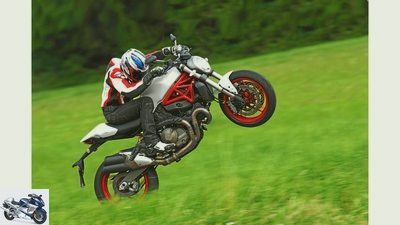
Bilski
12/34
Ducati and Kawasaki interpret the subject of the middle class in completely different ways …
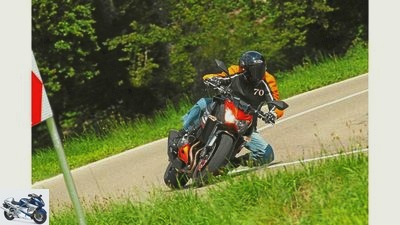
Bilski
13/34
… One of the few things they have in common: distancing themselves from the crowd.
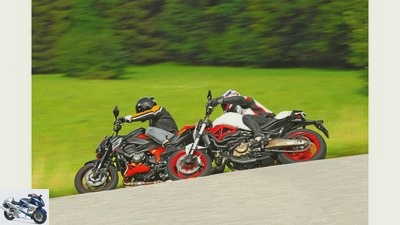
Bilski
14/34
Ducati Monster 821 and Kawasaki Z 800 in comparison test.
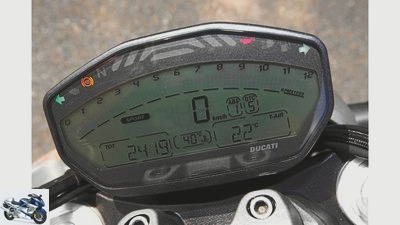
Bilski
15/34
The cockpit of the Ducati Monster 821 offers a lot of information, only the gear and fuel level displays are missing.
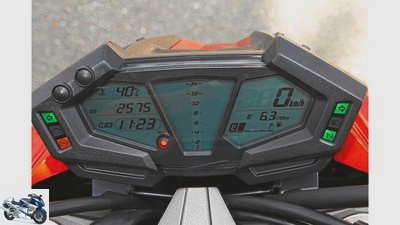
Bilski
16/34
The information center of the Kawasaki Z 800 also has to do without a gear indicator, the remaining range indicator is rather imprecise.
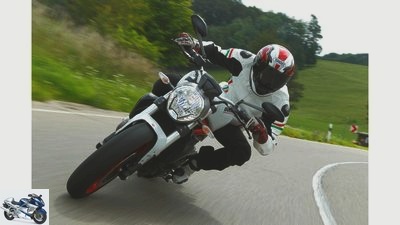
Bilski
17/34
Ducati Monster 821.
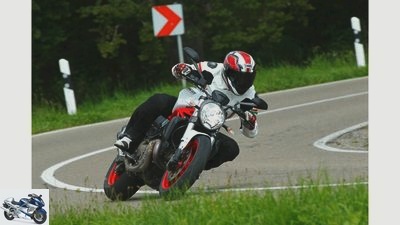
Bilski
18/34
Ducati Monster 821.
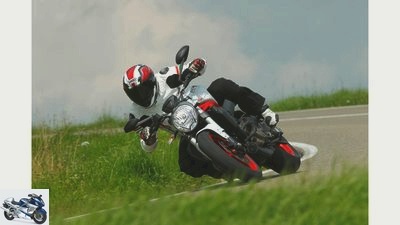
Bilski
19/34
Ducati Monster 821.
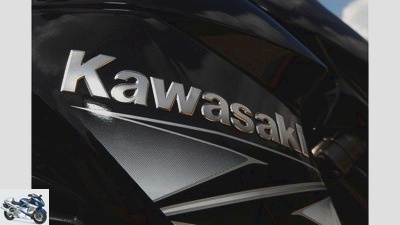
Bilski
20/34
Kawasaki Z 800.
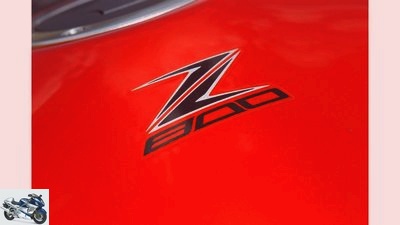
Bilski
21/34
Kawasaki Z 800.
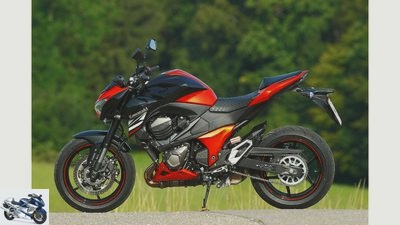
Bilski
22/34
Kawasaki Z 800.
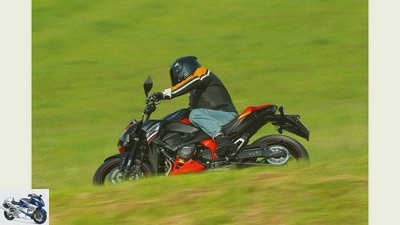
Bilski
23/34
Kawasaki Z 800.
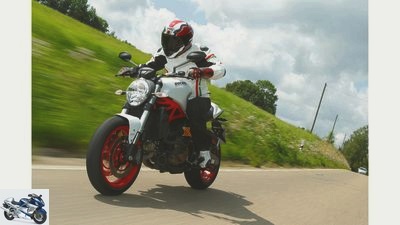
Bilski
24/34
Ducati Monster 821.
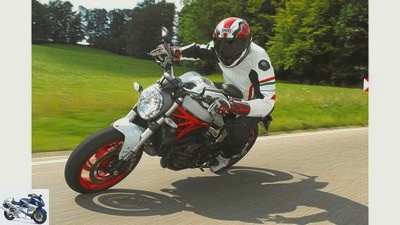
Bilski
25/34
Ducati Monster 821.
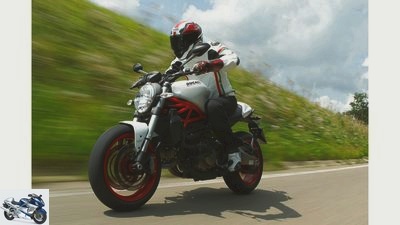
Bilski
26/34
Ducati Monster 821.
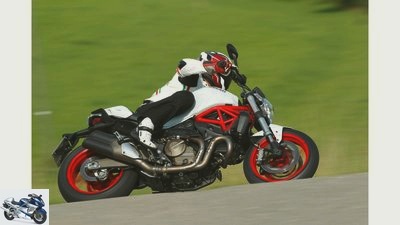
Bilski
27/34
Ducati Monster 821.
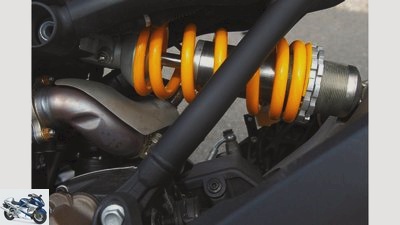
Bilski
28/34
Ducati Monster 821.
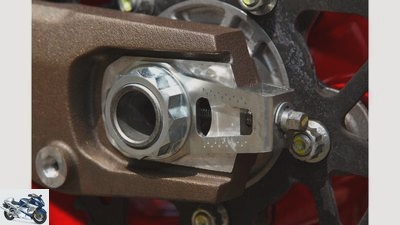
Bilski
29/34
Ducati Monster 821.
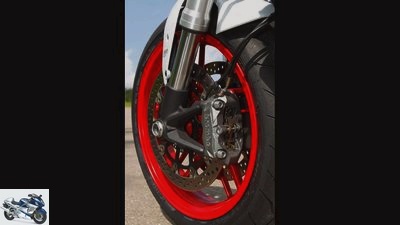
Bilski
30/34
Ducati Monster 821.
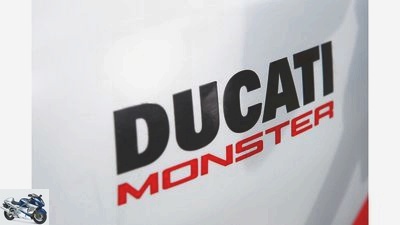
Bilski
31/34
Ducati Monster 821.
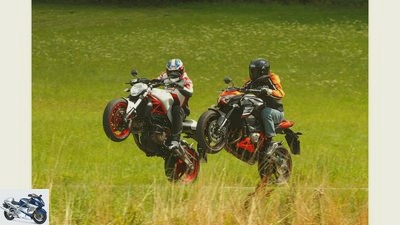
Bilski
32/34
Ducati Monster 821 and Kawasaki Z 800.
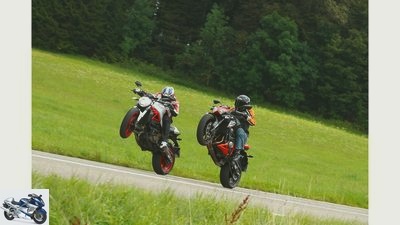
Bilski
33/34
Ducati Monster 821 and Kawasaki Z 800.
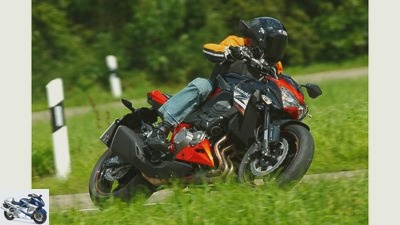
Bilski
34/34
Kawasaki Z 800.
Ducati Monster 821 and Kawasaki Z 800 in the test
Two concepts, one champion
Content of
The Ducati Monster 821 and the Kawasaki Z 800 belong to the middle class, don’t care about social dictates and consistently do their thing. Other similarities? Nothing. Two concepts, but only one is the champion.
When Italian and Japanese bikes meet, a clash of cultures always breaks out. Ducati interprets extravagant, technically independent and with rounded lines with the new D.ucati Monster 821 the middle-class naked theme. The test machine attracts with a bright red painted tubular space frame, finely drawn tank / bench combination and external manifolds with beveled double pipe exhaust. Pragmatic, technically conservative and with an aggressive design, on the other hand, the Kawasaki Z 800 vies for potential customers. She covers her bridge frame with jagged trim pieces and shamelessly flaunts the clunky muffler. Despite its massive appearance, the Zett looks very aggressive thanks to its crouched, front-heavy position.
Buy complete article
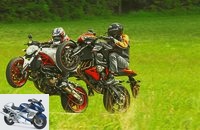
Ducati Monster 821 and Kawasaki Z 800 in the test
Two concepts, one champion
Monster 821 is the youngest model in which Ducati has put its smallest water-cooled drive. The 821 cubic V2 has been doing its job in the Hypermotard and Hyperstrada for some time. With the Monster, all new Ducati now run exclusively with water cooling. The Scrambler planned for 2015 is an exception. It will carry the 803 cubic drive of the previous 796 models.
The eternal dispute of the systems: V2 against inline four-cylinder
Our test bench for the Ducati Monster 821 spits out a juicy 107 hp, and thus exactly the nominal power. Sure, throttle-full-open freaks who are spoiled for performance will not be knocked off their feet. Nevertheless, the drive makes a lot of fun and is also suitable for proper country road bolts. Especially since the V2 reacts very willingly to gas commands. It is therefore all the more surprising that the initial momentum already subsides after a few tenths of a second. Presumably the throttle valves open much more slowly than the pilot dictates via ride-by-wire. Quick check: the sport mode is active, that fits. And under the “Engine” menu item, the “High” level (most direct response behavior) is set, which also works. The explanation is that Ducati apparently controls the throttle valve very conservatively.
Less restrained, however, the exhaust thunders the sound into the open. “Great!” Says Giovanni, our Italian intern. “Clearly too loud” and “how does Ducati manage the homologation again and again?”, However, wonders the Teutonic parliamentary group. But even this one flits a grin on his face when the Ducati Monster 821 fires from its pipes after short, crisp bursts of gas. There is also agreement in terms of performance. The strong and smooth acceleration from around 2000 rpm is impressive, as is the refreshingly free rev up to 9500 rpm. Between 4000 and 6000 rpm, however, the twin takes a noticeable breather, which slows down the Duc driver a bit when hunting. Spoiled gearshift feet also annoy the bony gear. Nevertheless, the positive impression prevails, because the drive accelerates wonderfully smoothly in each of its three driving modes, runs extremely cultivated and sends exquisite V2 pounding to the pilot.
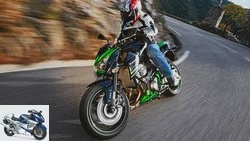
Naked bike
The new mid-range naked bike from Kawasaki
Top test: Kawasaki Z 800
read more
Buy a used Kawasaki Z 800
The four-cylinder Kawasaki Z 800 is rougher
The four-cylinder Kawasaki Z 800 is much rougher. Fine-nerved vibrations accompany the journey through the rev range over long distances, especially around 8000 rpm they are very pronounced. In addition, the Zett accelerates with a slight delay – a tiresome issue for the 800s. Once under tension, however, it implements every turn of the shower one-to-one and the power unit delivers its punch wonderfully evenly up to 10,000 rpm. With this brand, the quadruplet delivers its highest output with 110 hp.
In conjunction with the short gear ratio, the Kawasaki Z 800 gives the Ducati Monster 821 a whopping 1.2 seconds in the pull-through exercise from 50 to 150 km / h in the last gear. That doesn’t sound like a lot. The higher tractive force is clearly noticeable and also always present in the other gears – a big plus for the Japanese! Another is the gearbox, which does not work super smoothly, but enables smoother gear changes in direct comparison. And the sound? Grim! A muffled intake growl mixes with a hotter four-cylinder roar. The fact that it cannot ultimately decide the engine chapter for itself is mainly due to the lack of traction control – the Kawa leaves many points here.
Ducati Monster 821 weighs 22 kilos less
Does the Ducati Monster 821 of the Kawasaki Z 800 also overburn with the chassis? There is a lot to be said for it. Because at 208.5 kilograms, the Italian weighs over 22 kilograms less than the Kawa, which tows a full 231 kilograms to the scales. In addition, the gyroscopic forces of the narrower V2 crankshaft are lower than those of the sweeping four-cylinder part. Both have handling advantages. Last but not least, there is a 40 millimeter wider handlebar on the Monster, the lever of which makes it easy to control the load. Thanks to this package, the Duc angles nicely and nimbly and sticks precisely into the corners even on the brakes. To do this, it circles stably through the course in an inclined position and remains true to the targeted line.
And the Kawasaki Z 800? The Zett driver needs significantly more force to guide his pedestal through the arches. In addition, the 800s stand up noticeably when turning on the brakes, and the Kawasaki does not quite pull the exact line of the Ducati even in an inclined position. The Japanese woman demands a determined trainer who takes the bull by the horns. The front-wheel-oriented, active seating position goes well with this. The Ducati Monster 821, on the other hand, places its pilot lower and further back, and its handlebars are higher. Japan also has slight advantages in terms of the front suspension elements.
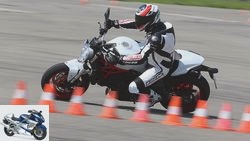
Naked bike
Ducati Monster 821 in the top test
A crowd-puller even while standing
read more
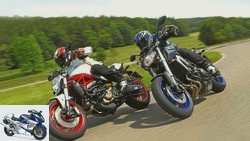
Naked bike
Ducati Monster 821 and Yamaha MT-09 in comparison
Racy Italian versus reserved Japanese
read more
ABS on board on both bikes
The fork is adjustable at least in the rebound stage, responds better and dips less when anchoring than the non-adjustable, stucky Ducati part. On the other hand, there is a tie for the shock absorber. The monoshock of the Ducati Monster 821 is very tightly damped, but with the rebound stage fully open, it swallows even rough asphalt distortions very reasonably. With a corresponding setup, the same applies to the Kawasaki Z 800.
The brakes of the Ducati Monster 821 are unusually sharp. This is great for sporty insoles, but less experienced people first have to approach the poisonous stoppers. Fortunately, a three-way adjustable ABS is on board, but only on the gentlest level (3) keeps the rear wheel clean on the ground, apart from the occasional mini stoppies. For heavy decelerations, the Kawasaki Z 800 driver has to pull the lever a little harder, but the braking effect is perfectly fine. The non-adjustable, compliant ABS is also convincing. As mentioned at the beginning, there is more that separates the two than they unite. In doing so, they impressively show that very different paths can lead to the goal – champion or not.
Technical data Ducati Monster 821
Bilski
The chocolate side of the Monster 821 is the handy and precise chassis that can handle even the sporty pace.
drive: Two-cylinder 90-degree V-engine, four valves / cylinder, 79 kW (107 PS) at 9250 / min *, 89 Nm at 7750 / min *, 821 cm³, bore / stroke: 88.0 / 67.5 mm, compression ratio: 12.8: 1, ignition / injection system, 53 mm throttle valves, mechanically operated multi-disc oil bath anti-hopping clutch, six-speed gearbox, G-Kat, chain, traction control
chassis & Brakes: Steel tubular space frame, load-bearing motor, steering head angle: 65.7 degrees, caster: 93 mm, wheelbase: 1480 mm, upside-down fork, Ø fork inner tube: 43 mm, not adjustable. Directly hinged central spring strut, adjustable in spring base and rebound damping. Spring travel front / rear: 130/140 mm, cast light alloy wheels, 3.50 x 17 / 5.50 x 17, front tires: 120/70 ZR 17, rear: 180/60 ZR 17, first tires: Pirelli Diablo Rosso 2, front in “D “, 320 mm double disc brake with four-piston fixed calipers attached radially at the front, 245 mm single disc with two-piston fixed caliper at the rear, ABS
performance:
Max. Rear wheel power **: 72.8 kW (99 PS) at 195 km / h
Acceleration **: 0-100 km / h: 3.3 s; 0-150 km / h: 6.6 s; 0-200 km / h: 13.8 s
Pulling speed **: 50-100 km / h: 5.4 s; 100–150 km / h: 5.8 s
Top speed *: 225 km / h
Dimensions and weight: Length / width / height: 2154/867/1061 mm, seat / handlebar height: 810 (775) / 1025 mm, handlebar width: 760 mm, 208.5 kg with a full tank, v./h .: 48.8 / 51.2%
Consumption Type of fuel: Super unleaded. Average test consumption: 6.4 liters / 100 km, tank capacity 17.5 liters, range: 273 km
Set up:
Setup fork: stat.neg. Spring travel: not adjustable, compression stage: not adjustable, rebound stage: not adjustable, level: standard
Setup shock absorber: stat.neg. Spring travel: 10 mm, compression: not adjustable, rebound: completely open, level: standard
Base price: 10,490 euros, test machine: 10,690 euros (plus additional costs)
Technical data Kawasaki Z 800
Bilski
On the plus side of the Kawa is the extremely powerful engine that gives the Zett a great dynamic.
drive: Four-cylinder in-line engine, four valves / cylinder, 83 kW (113 hp) at 10,200 / min *, 83 Nm at 8,000 / min *, 806 cm³, bore / stroke: 71.0 / 50.9 mm, compression ratio: 11, 9: 1, ignition / injection system, 34 mm throttle valves, mechanically operated multi-plate oil bath clutch, six-speed gearbox, G-Kat, chain,
chassis & Brakes: Steel bridge frame, steering head angle: 66.0 degrees, caster: 98 mm, wheelbase: 1455 mm, upside-down fork, Ø fork inner tube: 41 mm, adjustable spring base and rebound damping. Central spring strut with deflection, adjustable in spring base and rebound damping. Spring travel front / rear: 120/137 mm, light alloy cast wheels, 3.50 x 17 / 5.50 x 17, front tires: 120/70 ZR 17, rear: 180/55 ZR 17, first tires: Dunlop D 214 “J”, 310- mm double disc brake with four-piston fixed calipers at the front, 250 mm single disc with single-piston floating caliper at the rear, ABS
Performance:
Max. Rear wheel power **: 75.7 kW (103 PS) at 200 km / h
Acceleration **: 0-100 km / h: 3.3 s; 0-150 km / h: 6.4 s; 0-200 km / h: 14.0 s
Pulling speed **: 50-100 km / h: 4.9 s; 100-150 km / h: 5.1 s
Top speed *: 230 km / h
Dimensions and weight: length / width / height: 2113/830/1300 mm, seat / handlebar height: 820/1020 mm, handlebar width: 720 mm, 231 kg fully fueled, v./h .: 50.4 / 49.6%
Consumption Type of fuel: Super unleaded. Average test consumption: 6.1 liters / 100 km, tank capacity 17 liters, range: 278 km
Set up:
Setup fork: stat.neg. Spring travel: 30 mm, compression: not adjustable, rebound: 10 K open, level: standard
Setup shock absorber: stat.neg. Spring travel: 15 mm, compression: not adjustable, rebound: 0.75 U open, level: standard
Base price: 8,995 euros, test machine: 8,995 euros (plus additional costs)
Readings
Bilski
Power on the crankshaft, measurements on Dynojet roller dynamometer 250.
The Kawasaki Z 800 draws a clean power and torque curve in the diagram (green). It builds up its punch very evenly, you don’t feel the mini dents when driving. Despite its extra weight of over 22 kilos, it outperforms the Ducati Monster 821 in the pull-through exercise from 50 to 150 km / h in the last gear. It owes this to its gear ratio, which is nice and short due to the high speed reserves. The pilot clearly notices the loss of performance of the Italian between 4000 and 6000 rpm. In contrast to “Touring” and “Sport”, the Monster does not deliver full power in urban mode (light brown curve).
rating
Bilski
The Ducati Monster 821 places its pilot lower and further behind compared to the Kawasaki Z 800.
| Max. Points | Ducati Monster 821 | Kawasaki Z 800 | |
| drive | |||
| acceleration | 10 | 4th | 4th |
| Draft | 10 | 5 | 6th |
| Power delivery | 10 | 6th | 9 |
| Responsiveness | 10 | 6th | 8th |
| Load change reaction | 10 | 9 | 7th |
| Running culture | 10 | 9 | 6th |
| Gear actuation | 10 | 6th | 8th |
| Gear ratio | 10 | 8th | 9 |
| Clutch function | 10 | 8th | 6th |
| Traction control | 10 | 9 | – |
| Subtotal | 100 | 70 | 63 |
| Max. Points | Ducati Monster 821 | Kawasaki Z 800 | |
| landing gear | |||
| Driving stability | 10 | 8th | 8th |
| Handiness | 10 | 9 | 7th |
| Cornering stability | 10 | 9 | 7th |
| feedback | 10 | 8th | 9 |
| Suspension tuning in front | 10 | 6th | 8th |
| Chassis set-up at the rear | 10 | 7th | 7th |
| Braking effect | 10 | 9 | 9 |
| Brake metering | 10 | 9 | 8th |
| Erection moment when braking |
10 | 8th | 5 |
| ABS function | 10 | 9 | 8th |
| Subtotal | 100 | 82 | 76 |
| Max. Points | Ducati Monster 821 | Kawasaki Z 800 | |
| Everyday life and driving fun | |||
| Sitting position | 10 | 7th | 9 |
| Windbreak | 10 | 1 | 1 |
| Furnishing | 10 | 8th | 6th |
| consumption | 10 | 7th | 7th |
| Driving fun | 10 | 9 | 8th |
| Subtotal | 50 | 32 |
31
| Max. Points | Ducati Monster 821 | Kawasaki Z 800 | |
| Total | 250 | 184 | 170 |
| placement | 1. | 2. |
Bottom line and conclusion
Bilski
Advantages in the disciplines of handling, accuracy, cornering stability: The Ducati Monster 821 wins the race against the Kawasaki Z 800.
1. Ducati Monster 821
The Ducati Monster 821 celebrates a successful debut with a clear test victory. The best thing about it is the handy and precise chassis that can handle even the sporty pace. The very sophisticated engine is also pleasing. The fly in the ointment is the braked forward thrust shortly after applying the gas. In addition, the torque drop at medium speeds is quite pronounced. Nevertheless, the Monster 821 is a personable country road sweeper.
2. Kawasaki Z 800
On the plus side of the Kawasaki Z 800 is the extremely powerful engine that gives the Zett great dynamism. On the drive side, it gives away a few points because of a lack of traction control, rough engine running and delayed throttle response. But especially with the chassis it leaves a lot of springs. Handling, accuracy, cornering stability: the Ducati Monster 821 simply does better.
Related articles
-
Comparison test: super sports cars under 1000 cubic meters from MV Agusta, Ducati and Kawasaki
Jahn 46 pictures Jahn 1/46 Kawasaki ZX-6R 636 Jahn 2/46 But the Evo is not alone in this. All three bikes rock the ring during the test. Jahn 3/46 ……
-
Kawasaki Z 1000 – model years 2004 and 2014 in a comparison test
fact 16 photos fact 1/16 Memories of the old Z 900 and Z 1000 times were awakened by the “four-in-two-in-four exhaust system” with its four individual…
-
Comparison test Ducati 916 Biposto, Honda CBR 900 RR and Triumph Daytona T 595
Comparison test of the Ducati 916 Biposto, Honda CBR 900 RR and Triumph Daytona T 595 fire and flame It had to happen that way. Everyone has written it,…
-
BMW, Honda, Kawasaki, Suzuki and Yamaha super sports cars in a comparison test
Judd 26th photos Nicolaou 1/26 In the supersports comparison test: Kawasaki ZX-10R, BMW S 1000 RR, Suzuki GSX-R 1000, Honda Fireblade C-ABS and Yamaha…
-
Kawasaki ZX-10R and BMW S 1000 RR in a comparison test
www.bilski-fotografie.de 25th photos www.bilski-fotografie.de 1/25 First, let’s take a look at the new Kawasaki ZX-10R. www.bilski-fotografie.de 2/25 In…
-
Ducati 1199 Panigale S versus KTM RC8 R in comparison test
23 photos 1/23 The two super sports two-cylinder, KTM RC8 R and Ducati 1199 Panigale S, in a comparison test. They are the last…
-
Test of the Ducati Monster 1100 Evo
Jahn Ducati’s cult bike in the test Test: Ducati Monster 1100 Evo Content of Sunshine and empty streets. A dream ambience to indulge in a beautiful,…
-
Ducati 999 S and Ducati 1199 Panigale S in comparison test
fact 14th photos fact 1/14 The rattling through the city with the Ducati 999 S is deep in the memory. But honestly, the current Ducati Panigale with the…
-
Comparison test BMW S 1000 RR, Kawasaki ZX-10R and Yamaha YZF-R1M
22nd photos 1/22 BMW S 1000 RR, Kawasaki Ninja ZX-10R and Yamaha YZF-R1M. 2/22 Yamaha YZF-R1M. 3/22…
-
Comparison test BMW K 1300 S, Kawasaki ZZR 1400, Suzuki Hayabusa 1300
Gargolov Comparison test BMW K 1300 S, Kawasaki ZZR 1400, Suzuki Hayabusa 1300 Speed bikes in comparison The wind tunnel formed their faces, their…